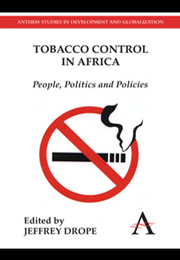Book contents
- Frontmatter
- Contents
- List of Figures and Tables
- Foreword
- Preface
- Acknowledgments
- List of Abbreviations and Acronyms
- 1 Introduction
- 2 The Political Mapping Process
- 3 Progress on Smoke-Free Policies
- 4 Taxation as a Tobacco Control Strategy
- 5 The Challenges of Implementing Bans on Advertising, Promotion and Sponsorship
- 6 The Pursuit of Packaging and Labeling Requirements
- 7 Burkina Faso
- 8 Cameroon
- 9 Eritrea
- 10 Ghana
- 11 Kenya
- 12 Malawi
- 13 Mauritius
- 14 Nigeria
- 15 Senegal
- 16 South Africa
- 17 Tanzania
- 18 Zambia
- 19 Conclusion: Tobacco Control in Africa – People, Politics and Policies
- Notes on Contributors
- Index
2 - The Political Mapping Process
Published online by Cambridge University Press: 05 March 2012
- Frontmatter
- Contents
- List of Figures and Tables
- Foreword
- Preface
- Acknowledgments
- List of Abbreviations and Acronyms
- 1 Introduction
- 2 The Political Mapping Process
- 3 Progress on Smoke-Free Policies
- 4 Taxation as a Tobacco Control Strategy
- 5 The Challenges of Implementing Bans on Advertising, Promotion and Sponsorship
- 6 The Pursuit of Packaging and Labeling Requirements
- 7 Burkina Faso
- 8 Cameroon
- 9 Eritrea
- 10 Ghana
- 11 Kenya
- 12 Malawi
- 13 Mauritius
- 14 Nigeria
- 15 Senegal
- 16 South Africa
- 17 Tanzania
- 18 Zambia
- 19 Conclusion: Tobacco Control in Africa – People, Politics and Policies
- Notes on Contributors
- Index
Summary
This chapter explains the political mapping process that teams from the African Tobacco Situational Analyses (ATSA) initiative utilized to examine the political, economic and social contexts in which they were seeking to reform tobacco control policy. In brief, the process asks proponents of policy change to identify relevant domestic and international institutions and interests, and to consider how their roles and interactions help to shape policy in a particular country. The process is broadly framed by two theoretical constructs borrowed from the political science literature: both political institutions and interest groups influence policymaking and policy outcomes – independently and interactively. More specifically, it is the principal structural and organizational characteristics of the two entities, in addition to how they interact, that significantly shape policy. In other words, the individuals may change, but the types of actors and the institutional structures tend to be relatively static and deeply influence the making of policies and the outcomes generated by them. Understanding the fundamental nature of these central components can contribute markedly to successful navigation of the policy process.
Proponents of the so-called “new institutionalism” maintain that the actual structure of the political system will significantly condition outcomes. These structures include major features such as presidential versus parliamentary systems, unitary versus federal designs and the relative development and influence of the judicial branch, but also less obvious ones such as the autonomy and power of government ministries and the cabinet.
- Type
- Chapter
- Information
- Tobacco Control in AfricaPeople, Politics and Policies, pp. 13 - 28Publisher: Anthem PressPrint publication year: 2011



